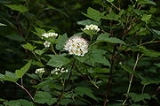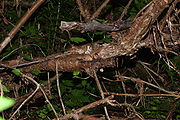
Physocarpus capitatus
Encyclopedia
Physocarpus capitatus, commonly called Pacific ninebark or tall ninebark, is a species of Physocarpus
native to western North America
from southern Alaska
east to Montana
and Utah
, and south to southern California
.
 It is a dense deciduous shrub
It is a dense deciduous shrub
growing to 1 to 2.5 meters tall. The name comes from the appearance of the bark
, which is flaky, peeling away in many layers. The shrub has distinctive maple
-like lobed leaves
3-14 cm long and broad, and clusters of small white flower
s with five petals and numerous red-tipped stamens. The unique fruit
is an inflated glossy red pod which turns dry and brown and then splits open to release seeds.
It is often found in wetland
s, but also forms thickets along rivers and in moist forest habitats. While it grows most robustly in wet environments, it is drought-tolerant to a degree and is a popular California garden plant.
Physocarpus
Physocarpus, commonly called Ninebark, is a genus of about ten species of flowering plants in the family Rosaceae, native to North America and northeastern Asia ....
native to western North America
North America
North America is a continent wholly within the Northern Hemisphere and almost wholly within the Western Hemisphere. It is also considered a northern subcontinent of the Americas...
from southern Alaska
Alaska
Alaska is the largest state in the United States by area. It is situated in the northwest extremity of the North American continent, with Canada to the east, the Arctic Ocean to the north, and the Pacific Ocean to the west and south, with Russia further west across the Bering Strait...
east to Montana
Montana
Montana is a state in the Western United States. The western third of Montana contains numerous mountain ranges. Smaller, "island ranges" are found in the central third of the state, for a total of 77 named ranges of the Rocky Mountains. This geographical fact is reflected in the state's name,...
and Utah
Utah
Utah is a state in the Western United States. It was the 45th state to join the Union, on January 4, 1896. Approximately 80% of Utah's 2,763,885 people live along the Wasatch Front, centering on Salt Lake City. This leaves vast expanses of the state nearly uninhabited, making the population the...
, and south to southern California
California
California is a state located on the West Coast of the United States. It is by far the most populous U.S. state, and the third-largest by land area...
.

Shrub
A shrub or bush is distinguished from a tree by its multiple stems and shorter height, usually under 5–6 m tall. A large number of plants may become either shrubs or trees, depending on the growing conditions they experience...
growing to 1 to 2.5 meters tall. The name comes from the appearance of the bark
Bark
Bark is the outermost layers of stems and roots of woody plants. Plants with bark include trees, woody vines and shrubs. Bark refers to all the tissues outside of the vascular cambium and is a nontechnical term. It overlays the wood and consists of the inner bark and the outer bark. The inner...
, which is flaky, peeling away in many layers. The shrub has distinctive maple
Maple
Acer is a genus of trees or shrubs commonly known as maple.Maples are variously classified in a family of their own, the Aceraceae, or together with the Hippocastanaceae included in the family Sapindaceae. Modern classifications, including the Angiosperm Phylogeny Group system, favour inclusion in...
-like lobed leaves
Leaf
A leaf is an organ of a vascular plant, as defined in botanical terms, and in particular in plant morphology. Foliage is a mass noun that refers to leaves as a feature of plants....
3-14 cm long and broad, and clusters of small white flower
Flower
A flower, sometimes known as a bloom or blossom, is the reproductive structure found in flowering plants . The biological function of a flower is to effect reproduction, usually by providing a mechanism for the union of sperm with eggs...
s with five petals and numerous red-tipped stamens. The unique fruit
Fruit
In broad terms, a fruit is a structure of a plant that contains its seeds.The term has different meanings dependent on context. In non-technical usage, such as food preparation, fruit normally means the fleshy seed-associated structures of certain plants that are sweet and edible in the raw state,...
is an inflated glossy red pod which turns dry and brown and then splits open to release seeds.
It is often found in wetland
Wetland
A wetland is an area of land whose soil is saturated with water either permanently or seasonally. Wetlands are categorised by their characteristic vegetation, which is adapted to these unique soil conditions....
s, but also forms thickets along rivers and in moist forest habitats. While it grows most robustly in wet environments, it is drought-tolerant to a degree and is a popular California garden plant.
External links
- Jepson Flora Project: Physocarpus capitatus
- NRCS: USDA Plants Profile Physocarpus capitatus, http://plants.usda.gov/java/largeImage?imageID=phca11_004_ahp.tif, OR,WA,ID,CA http://plants.usda.gov/java/profile?symbol=PHCA11, CA: http://plants.usda.gov/java/county?state_name=California&statefips=06&symbol=PHCA11

